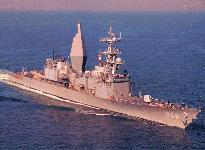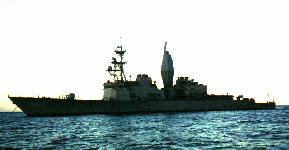

DD-963 SPRUANCE-class Image Gallery






Built with future growth in mind, their design is modular in nature, allowing for easy installation of entire subsystems within the ship. Space and power reservations have been made to accommodate future weapons and electronics systems as they are developed. Originally developed as Anti-Submarine (ASW) destroyers, 24 ships of this class were upgraded with the installation of a 61 cell Vertical Launch Missile System (VLS) capable of launching Tomahawk and Harpoon missiles.
Navy destroyers have historically been retired by 30 years of service. But in 1998 the seven Spruance-class destroyers which did not receive the Tomahawk VLS upgrade are being decommissioned after only two decades of service, to accomodate the introduction of the improved AEGIS-capable Arleigh Burke destroyers. All decommissioned ships are scheduled to be scrapped
The Spruance-class destroyer's inherent capabilities make it an ideal ship for surveillance operations. Endurance and response from the ship's four gas turbine engines make it possible to conduct such operations with minimal notice and with less fuel logistics concerns. Excellent command and control capabilities assures a thorough, carefully controlled effort. ANTI-SUBMARINEAnti-submarine warfare capabilities include a sonar suite that contains the most advanced underwater detection and fire control system yet developed. ASW weapons include two triple-barrel Mk 32 torpedo tubes and the Vertical Launch ASROC missile. In addition the ships can embark two SH-60B LAMPS Mk III helicopters to extend the range of the ship's weapons and sensors. Ultimately fitted with the SQS-53 hull-mounted active sonar, SQR-19 tactical towed passive acoustic array, anti-submarine rocket (ASROC) launchers and with twin hangars for LAMPS Mk III helicopters, these ships were in the forefront of the surface Navy�s defense against submarine attacks.
The equipment on board SPRUANCE enables detection of submarines at considerable ranges. The Sound Navigation and Ranging (SONAR) transmits a sound wave, which is reflected by the submarine to allow range and bearing assessment. When the position of the submarine has been determined, either by the ship or the ship's SH-60B Helicopter, computers will pass the necessary information to Anti-Submarine Rocket (ASROC) Missile System and the helicopter. An attack can be conducted with the ASROC (rocket-thrown torpedo). Once the ASROC is fired, at a predetermined time, the missile releases a homing torpedo which hunts down the submarine until it is destroyed. An attack can be conducted using the ASROC or a torpedo launched from the ship's torpedo launchers. SPRUANCE can stream a decoy from the stern to divert torpedoes fired at the ship. Another device, an expendable bathythermograph (XBT) measures the sea's temperature at varying depths and indicates how SONAR waves are bent by layers of warmer and colder water.AN/SQR-19 The AN/SQR-19 Tactical Towed Array SONAR (TACTAS) is a series of acoustic modules designed to be towed at the end of a long cable out of the stern of the ship. This allows for the reduction of the noise emanating from the SPRUANCE and increasing the ship's passive capability. The Hoist Room, located under the fantail, contains the cable and the array. The display consoles are located in SONAR Control. AN/SQQ-89 SONAR SYSTEM The AN/SQQ-89 SONAR System is designed to incorporate several subsystems, including the AN/SQS-53B Hull-Mounted SONAR, AN/SQS-19 Towed Array, LAMPS MK III Sonobuoys, and MK 116 MOD 6 Underwater Fire Control System (UFCS). It is the most advanced SONAR system in today's Fleet. Combining three SONAR systems and a fire control system into one suite, it gives SPRUANCE the ability to use the best of all systems, while overcoming the disadvantages of any one system. SH-60B HELICOPTER The Light Airborne Multi-Purpose Systems, or LAMPS MK III, is a twin-engine helicopter that carries a crew of two pilots and a sensor operator/crewman. The primary mission of LAMPS MK III is Anti-Submarine Warfare. The SH-60B Seahawk is equipped with a sonobuoy deployment and interpretation system, Magnetic Anomaly Detection (MAD) gear, and threat detection/display equipment. Additionally, the aircraft is capable of carrying ASW torpedoes. LAMPS MK III secondary missions include gunfire spotting, over-the-horizon targeting, MEDEVAC, and search and rescue operations. SPRUANCES's flight deck has been modified to accommodate the Recovery Assist Securing and Transversing (RAST) System. This system allows helicopter flight operations in heavy weather.ANTI-SURFACE
These ships have traditionally had a major role in Naval Surface Fire Support for troops ashore, employing Harpoon antiship missiles and two 5-inch guns (also used for air defense and shore bombardment). The Harpoon Missile System is proven effective in engaging shipping at intermediate ranges. Fitted with two MK 45 lightweight 5 inch/54 caliber guns guns when built, their main battery can throw a projectile over 12 miles with a firing rate of 20 rounds per minute. The five-inch/54-caliber gun represents a major step forward in medium- caliber ordnance for the U.S. Navy. The result is a weapon which allows a single man in a control center to fire a load of 20 shells without help.
ANTI-AIRSpecifications | |
| Power plant | 4 - LM 2500 General Electric gas turbines two shafts, 80,000 shaft horsepower |
| Length | 563 feet (171.6 meters) |
| Beam | 55 feet (16.8 meters) |
| Displacement | 9,100 tons (8,190 metric tons) full load |
| Speed | 33 knots (38 mph, 60.8 kph) |
| Range | 6000 NM @ 20 knots |
| Aircraft | Two SH-60 Seahawk LAMPS III helicopters |
| Crew | 30 officers, 352 enlisted |
| Armament |
2 - MK 143 Armored Box Launchers for Tomahawk SLCM or 1 - MK41 Vertical Launch System for Tomahawk SLCM 2 - MK 141 quad launchers w/ 8 Harpoon missiles MK 29 launchers for NATO Sea Sparrow Missile System 2 - MK 15 20mm Phalanx CIWS Close-In Weapons Systems 2 - 5-Inch 54 Cal. MK 45 Guns (lightweight gun) 2 - MK 32 triple tube mounts w/ six Mk-46 torpedoes) MK 112 Launcher for ASROC |
| Combat Systems |
SPS-40E Air Search Radar SPS-55 Surface Search Radar SPG-60 Gun Fire Control Radar SPQ-9A Gun Fire Control Radar SQS-53B Sonar SQR-19 Tactical Towed Array Sonar SLQ-32 (V)3 OUTBOARD II |
| COMMAND AND CONTROL |
JOTS Link 11 HF Radios UHF Radios VHF Radios |
| Unit Operating Cost Annual Average | ~$35,000,000 [source: [FY1996 VAMOSC] |
Ships | ||||||
| Name | Number | Builder | Homeport | Ordered | Commissioned | Decommissioned |
| Spruance | DD 963 | Ingalls | Mayport | 23 Jun 1970 | 20 Sep 1975 | 2005 |
| Paul F. Foster | DD 964 | Ingalls | Everett | 01 Jun 1970 | 21 Feb 1976 | 2006 |
| Kinkaid | DD 965 | Ingalls | San Diego | 01 Jun 1970 | 10 Jul 1976 | 2006 |
| Hewitt | DD 966 | Ingalls | Yokosuka | 01 Jan 1971 | 25 Sep 1976 | 2006 |
| Elliot | DD 967 | Ingalls | San Diego | 01 Jan 1971 | 22 Jan 1977 | 2007 |
| Arthur W. Radford | DD 968 | Ingalls | Norfolk | 15 Jan 1971 | 15 Apr 1977 | 2007 |
| Peterson | DD 969 | Ingalls | Norfolk | 15 Jan 1971 | 09 Jul 1977 | 2007 |
| Caron | DD 970 | Ingalls | Norfolk | 15 Jan 1971 | 01 Oct 1977 | 2007 |
| David R. Ray | DD 971 | Ingalls | Everett | 15 Jan 1971 | 19 Nov 1977 | 2007 |
| Oldendorf | DD 972 | Ingalls | San Diego | 26 Jan 1972 | 04 Mar 1978 | 2008 |
| John Young | DD 973 | Ingalls | San Diego | 26 Jan 1972 | 20 May 1978 | 2008 |
| Comte De Grasse | DD 974 | Ingalls | Norfolk | 26 Jan 1972 | 05 Aug 1978 | 05 Jun 1998 |
| O'Brien | DD 975 | Ingalls | Yokosuka | 26 Jan 1972 | 03 Dec 1977 | 2007 |
| Merrill | DD 976 | Ingalls | San Diego | 26 Jan 1972 | 11 Mar 1978 | 26 Mar 1998 |
| Briscoe | DD 977 | Ingalls | Norfolk | 26 Jan 1972 | 03 Jun 1978 | 2008 |
| Stump | DD 978 | Ingalls | Norfolk | 26 Jan 1972 | 19 Aug 1978 | 2008 |
| Connolly | DD 979 | Ingalls | Mayport | 15 Jan 1974 | 14 Oct 1978 | Sep 1998 |
| Moosbrugger | DD 980 | Ingalls | Mayport | 15 Jan 1974 | 16 Dec 1978 | 2008 |
| John Hancock | DD 981 | Ingalls | Mayport | 15 Jan 1974 | 10 Mar 1979 | 2009 |
| Nicholson | DD 982 | Ingalls | Mayport | 15 Jan 1974 | 12 May 1979 | 2009 |
| John Rodgers | DD 983 | Ingalls | Mayport | 15 Jan 1974 | 14 July 1979 | 04 Sep 1998 |
| Leftwich | DD 984 | Ingalls | Pearl Harbor | 15 Jan 1974 | 25 Aug 1979 | 27 Mar 1998 |
| Cushing | DD 985 | Ingalls | Yokosuka | 15 Jan 1974 | 20 Oct 1979 | 2009 |
| Harry W. Hill | DD 986 | Ingalls | San Diego | 15 Jan 1975 | 17 Nov 1979 | 29 May 1998 |
| O'Bannon | DD 987 | Ingalls | Mayport | 15 Jan 1975 | 15 Dec 1979 | 2009 |
| Thorn | DD 988 | Ingalls | Norfolk | 15 Jan 1975 | 16 Feb 1980 | 2010 |
| Deyo | DD 989 | Ingalls | Norfolk | 15 Jan 1975 | 22 Mar 1980 | 2010 |
| Ingersoll | DD 990 | Ingalls | Pearl Harbor | 15 Jan 1975 | 12 Apr 1980 | 24 Jul 1998 |
| Fife | DD 991 | Ingalls | Everett | 15 Jan 1975 | 31 Mar 1980 | 2010 |
| Fletcher | DD 992 | Ingalls | Pearl Harbor | 15 Jan 1975 | 12 Jul 1980 | 2010 |
| Hayler | DD 997 | Ingalls | Norfolk | 29 Sep 1979 | 05 Mar 1983 | 2013 |



